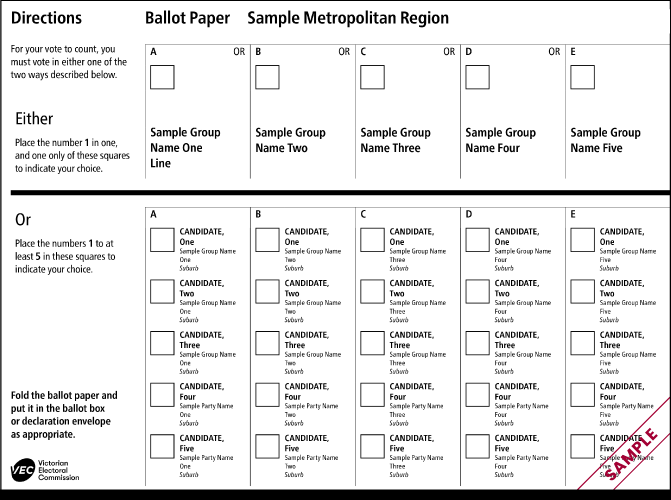How to fill out state ballot papers
Completing ballot papers
Voting is simpler than you think. When you vote in a State election you're voting for who you want to represent you in the two houses of the State Parliament.Upcoming state by-elections
There are upcoming state by-elections in Prahran and Werribee districts.
These districts are part of the lower house of the Victorian Parliament, so you will only receive one ballot paper.
When you vote in a State election, you are voting for who you want to represent you in the 2 houses of the State Parliament:
- the Legislative Assembly (Lower House)
- the Legislative Council (Upper House).
Lower House ballot paper

On the smaller Lower House ballot paper, you need to number every box in the order of your choice.
- Write the number 1 in the box next to the candidate who is your first choice.
- Write the number 2 in the box next the candidate who is your second choice.
- Continue writing the numbers 3, 4, 5 and so on until you have a number in every box.
If you're voting in a by-election, this is the only ballot paper you will get.
Upper House ballot paper

On the larger Upper House ballot paper, you can vote above the line or below the line.
Above the line
If you choose to vote above the line:
- Write the number 1 in the box next to the group of your choice.
- Leave the rest of the ballot paper blank.
- Do not write any numbers below the line.
If you vote above the line, your preferences will be decided by the group voting ticket(s) registered by the group you’ve chosen.
A group voting ticket is a statement on how each group gives preferences to other candidates. A group must register at least 1 group voting ticket, but can register up to 3 group voting tickets.
Below the line
If you choose to vote below the line:
- Write the number 1 in the box next to the candidate who is your first choice.
- Write the number 2 in the box next the candidate who is your second choice.
- Continue writing the numbers 3, 4, 5 and so on until you have numbered at least 5 boxes.
- Do not write any numbers above the line.
You can continue numbering more than 5 candidates, but for your vote to be counted you must number at least 5 boxes.
By voting below the line, you decide your preferences.
Formal and informal votes
A ballot paper that is filled out correctly is known as a formal vote. Formal votes are counted to determine the result of the election.
A ballot paper that has not been filled out correctly is known as an informal vote. Informal votes cannot be counted toward the election result.
A ballot paper can be considered informal when someone:
- puts ticks, crosses, or any other symbol in the boxes
- does not number enough boxes
- misses or repeats numbers
- leaves the ballot paper blank.
Donkey votes
A ballot paper that is numbered 1, 2, 3, 4, 5 (and so on) in the same order that the candidates are listed, is known as a ‘donkey vote’.
A donkey vote could be a voter not understanding how to vote, not caring how they vote, or could actually express the voter’s true preferences.
If all the boxes are numbered, donkey votes are formal and count toward the election result.
Making a mistake
If you make a mistake, that’s okay. You can cross it out and put the correct number next to it.
If you’re worried we won’t be able to interpret your corrections, you can return your ballot paper to the election staff and ask for a new one.
If you damage or tear your ballot paper, you can return it to the election staff and ask for a new one.

